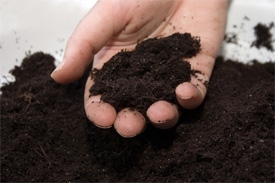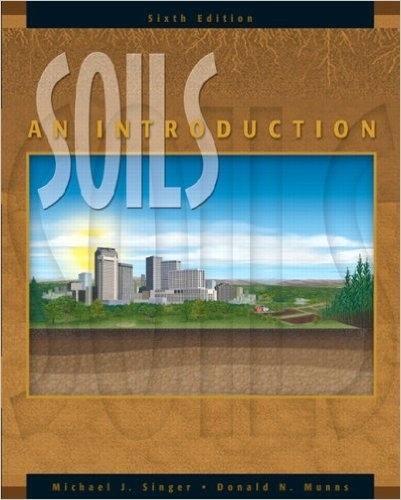
Posts Tagged: dirt
What's the Difference - Dirt, Soil, Earth?
Soil and agriculture courses are being taught again at Ventura College. This was a commitment of outgoing President, Greg Gillespie. There are only a handful California community (junior) colleges that still teach soils. Luckily Santa Barbara City, Allan Hancock, Pierce, Mira Costa and a few other community colleges in the Central Valley have at least introductory courses in soils. Many of the leading growers in Ventura County got their start in college taking soils courses at Ventura College, then went on to four-year colleges to round out their educations. The community college classes have always been a taste, a dusting of understanding of soils and if someone wanted to dig deeper, they would go on to somewhere like Davis, Fresno, Riverside, Pomona or San Luis. The community colleges are part of the continuum, start there and then go anywhere.

Dr. Jennifer Charles-Tollerup, the incoming Agriculture Instructor at Ventura College, brings a diverse set of experiences including 5 years in agricultural production systems, 4 years in agricultural research and education, 6 years in community college instruction as well as appointments in program development. She holds a PhD from the University of California, Riverside in Entomology with a concentration in Integrated Pest Management (IPM) and Statistics along with a Bachelor's from the University of California, Santa Cruz in Biology and Environmental Studies with emphasis in Botany and Agroecology. Jennifer trained as an Apprentice in Ecological Horticulture at UC Santa Cruz's Center for Agroecology and Sustainable Food Systems. She has worked on market gardens, family farms, and large-scale operations in citrus, grapes, nurseries, strawberries, herbs, lettuces, and edible flowers. Jennifer has used her academic and professional experience to coordinate elementary school garden programs.Jennifer readily supports the mission of the community college, to transform lives through education. Her approach involves building relationships with students and with agriculture partners, connecting the two together, and launching students into their life's work in agriculture. (this from CA Women in Ag newsletter, http://www.cwaventura.com/).More information about the Ventura College Agriculture Program can be found at http://www.venturacollege.edu/departments/academic/agriculture
Soil and agriculture courses are being taught again at Ventura College. There are only a handful California community (junior) colleges that still teach soils. Luckily Santa Barbara City, Allan Hancock, Pierce, Mira Costa and a few other community colleges have at least introductory courses in soils. Many of the leading growers in Ventura County got their start in college taking soils courses at Ventura College, then went on to four-year colleges to round out their educations. The community college classes have always been a taste, a dusting of understanding of soils and if someone wanted to dig deeper, they would go on to somewhere like Davis, Fresno, Riverside, Pomona or San Luis. The community colleges are part of the continuum, start there and then go anywhere.
Dr. Jennifer Charles-Tollerup, the incoming Agriculture Instructor at Ventura College, brings a diverse set of experiences including 5 years in agricultural production systems, 4 years in agricultural research and education, 6 years in community college instruction as well as appointments in program development. She holds a PhD from the University of California, Riverside in Entomology with a concentration in Integrated Pest Management (IPM) and Statistics along with a Bachelor's from the University of California, Santa Cruz in Biology and Environmental Studies with emphasis in Botany and Agroecology. Jennifer trained as an Apprentice in Ecological Horticulture at UC Santa Cruz's Center for Agroecology and Sustainable Food Systems. She has worked on market gardens, family farms, and large-scale operations in citrus, grapes, nurseries, strawberries, herbs, lettuces, and edible flowers. Jennifer has used her academic and professional experience to coordinate elementary school garden programs.
Jennifer readily supports the mission of the community college, to transform lives through education. Her approach involves building relationships with students and with agriculture partners, connecting the two together, and launching students into their life's work in agriculture. (this from CA Women in Ag newsletter, http://www.cwaventura.com/).
More information about the Ventura College Agriculture Program can be found at http://www.venturacollege.edu/departments/academic/agriculture
Come learn the dirt on the differences - ground, alluvium, subsoil, topsoil, mud, muck, marl, mire, smut - there are, but some terms are more subtle than others. Check out your local college for their soils course work.

soil weathered from rock
California State Soil - San Joaquin Series
Many states have a designated state bird, flower, fossil, mineral, etc. In California, the state bird is the California Valley Quail, the state flower is the Golden Poppy, the state fossil is the Sabertoothed Cat, and the state mineral is Native Gold. The state rock is Serpentine which contains chrysolite asbestos which is a carcinogen. It's a beautiful rock, though.
The state soil is the San Joaquin series. The series concept is that a given soil has certain properties like pH, depth, color, texture, etc. that distinguishes it from other “soils” or series. So wherever this soil is found it is given the same name. San Joaquin series is a soil that is found primarily along the foothills of the Sierras in the Central Valley. The name comes from where it is first described, in this case, San Joaquin, but it is found in other places. Yolo series is named after a soil on the campus at UC Davis in Yolo county, but it is also found in San Diego county, and in other states.
A description of the state soil can be found at the link below, as well as the state soils in other states:
http://www.soils4teachers.org/files/s4t/k12outreach/ca-state-soil-booklet.pdf
http://www.soils4teachers.org/state-soils
Soils can be highly variable depending on the context in which they are found. Going to flat old Kansas which is actually flatter than a pancake (http://www.usu.edu/geo/geomorph/kansas.html), the variability from spot to spot across miles can be minimal. But going to a place like Ventura, Santa Barbara, San Luis Obispo Counties of the Sierra foothills, you can't step on the same soil twice. That's because of the terrain and landforms. Where there is natural erosion (yes, it doesn't take humans to cause erosion) or accelerated erosion (this is where humans have often changed the landscape with roads, houses, removing ground cover) soil gets moved around and deposited in different positions and over time forms different soils with different properties. On large tracts of land that have not been altered much, such as avocado orchards, the naturally formed soils can be seen. In a housing tract where soil has been moved around to level and compact housing pads, it is often hard to find a natural soil because it is so highly disturbed. The soil can have been moved from one end of a 100 acres tract to the other with big equipment. It's all one big homogenous mix down to several feet at times depending on the slope.
In many cases, it is still possible to see the natural soils and knowing their series classification, it's possible to learn some of the properties and some of the problems that will be encountered when working with them. Knowing the pH prior to working it means that it could be adjusted before planting. It's a whole lot easier to adjust before planting than when the plants are in the ground.
You can see the soils in your area by going to the USDA-NRCS (Natural Resources Conservation Service) website - https://websoilsurvey.sc.egov.usda.gov/App/HomePage.htm - and typing in the area code to find the soil at a given site. It probably isn't the state soil series, but it's your soil series.
For a great text on understanding soils, check out Soils: An Introduction by Michael Singer and Don Munns.

soils
The Best Soils Text
I am frequently asked if I can recommend a book on Soils. And yes, I can. It is Soils: An Introduction by Michael Singer and Donald Munns. The sixth edition recently came out so there's a lot of older used copies floating around on the wed for under $10. This book takes a different tack on describing soils. Instead of tacking the tack of a chapter on Nitrogen another on Calcium etc., it weaves a story of how all the parts are related.

soils
